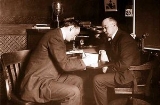
Major League Baseball
outfielder
. He was born in Narrows, Georgia
. Cobb spent 22 seasons with the Detroit Tigers
, the last six as the team's player-manager, and finished his career with the Philadelphia Athletics
.
Cobb is widely regarded as one of the best players of all time. In 1936, Cobb received the most votes of any player on the inaugural Baseball Hall of Fame ballot
, receiving 222 out of a possible 226 votes.
Cobb is widely credited with setting 90 Major League Baseball records during his career.
Ty was an intellectual giant. He was the most fascinating personality I ever met in baseball. To him, a ball game wasn't a mere athletic contest. It was a knock-'em-down, crush-'em, relenteless war. He was their enemy, and if they got in his way he ran right over them.![]()
He had a screw loose. I never knew anyone like him. It was like his brain was miswired so that the least damned thing would set him off.![]()
Ty was an intellectual giant. He was the most fascinating personality I ever met in baseball. To him, a ball game wasn't a mere athletic contest. It was a knock-'em-down, crush-'em, relenteless war. He was their enemy, and if they got in his way he ran right over them.![]()
He had a screw loose. I never knew anyone like him. It was like his brain was miswired so that the least damned thing would set him off.![]()

